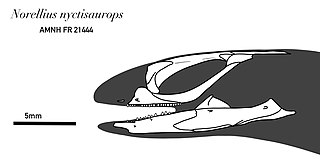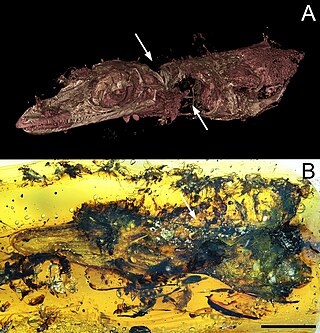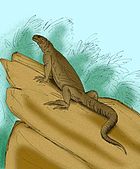
Quaesitosaurus is a genus of nemegtosaurid sauropod containing only the type species, Q. orientalis, described in 1983. It lived from 72 to 71 million years ago during the Late Cretaceous epoch in the Barun Goyot Formation. With long, low and horse-like with frontally located peg-teeth, the skull of Quaesitosaurus is similar enough to the skull of Diplodocus and its kin to have prompted informed speculation that the missing body was built like those of diplodocids.

Saurornithoides is a genus of troodontid maniraptoran dinosaur, which lived during the Late Cretaceous period. These creatures were predators, which could run fast on their hind legs and had excellent sight and hearing. The name is derived from the Greek stems saur~ (lizard), ornith~ (bird) and eides (form), referring to its bird-like skull.

Antarctosaurus is a genus of titanosaurian sauropod dinosaur from the Late Cretaceous Period of what is now South America. The type species, Antarctosaurus wichmannianus, and a second species, Antarctosaurus giganteus, were described by prolific German paleontologist Friedrich von Huene in 1929. Three additional species of Antarctosaurus have been named since then but later studies have considered them dubious or unlikely to pertain to the genus.

Alectrosaurus is a genus of tyrannosauroid theropod dinosaur that lived in Asia during the Late Cretaceous period, about some 96 million years ago in what is now the Iren Dabasu Formation.

Archaeornithoides is a genus of maniraptoran theropod dinosaur of the Late Cretaceous of Mongolia.

Tsaagan is a genus of dromaeosaurid dinosaur from the Djadokhta Formation of the Late Cretaceous of Mongolia.

Ceratonykus is a monospecific genus of alvarezsaurid dinosaur from Mongolia that lived during the Late Cretaceous in what is now the Barun Goyot Formation. The type and only species, Ceratonykus oculatus, is known from a fragmentary skeleton, including an incomplete skull, of an adult individual. It was named and described in 2009 by Vladimir Alifanov and Rinchen Barsbold. Its describers questioned the traditional placement of alvarezsaurs in Theropoda, instead suggesting they were ornithischians, but this has not been accepted since. Ceratonykus has an estimated length of 75 centimetres and weight of 760 grams. It has been considered as a possible junior synonym of Parvicursor.
Isodontosaurus is an extinct genus of iguanian lizard from the Late Cretaceous of Mongolia and China. The type species is Isodontosaurus gracilis. Isodontosaurus is part of an extinct group of Late Cretaceous iguanians called Gobiguania, which is currently thought to be endemic to Mongolia.
Liushusaurus is an extinct genus of lizard described by Susan E. Evans and Yuan Wang in 2010. The genus has a single species, Liushusaurus acanthocaudata, and is known from eight fossils, several of which preserve soft tissue detail. The specimens were found in the Lower Cretaceous aged Yixian Formation of Northeast China. Liushusaurus is one of eight lizards that are known and have been named from the Yixian Formation, part of the diverse Jehol Biota ecosystem.
Ovoo gurvel is an extinct varanid lizard from the Late Cretaceous of Mongolia. It is one of the smallest and earliest monitor lizards. It was described in 2008. Ovoo possesses a pair of two small bones in its skull that are not seen in any other lizard.
Gobekko is an extinct genus of gecko or gecko-like lizard from the Late Cretaceous Djadokhta Formation of the Gobi Desert in Mongolia. Gobekko is either a basal member of Gekkota, the group that includes geckos and the legless pygopodid lizards, or a stem-gekkotan outside Gekkota but within the larger group Gekkonomorpha. It is the fourth oldest known member of Gekkonomorpha after Hoburogekko, a gecko from the Early Cretaceous of Mongolia, AMNH FR21444, an unnamed specimen also from the Early Cretaceous of Mongolia, and Cretaceogekko, a gecko preserved in amber from the Early Cretaceous of Burma.
Hoburogekko is an extinct genus of gecko that includes a single species, Hoburogekko suchanovi, from the Early Cretaceous of Mongolia. It is known from two fossil specimens, one preserving the front part of the skull and the other preserving part of the lower jaw. Hoburogekko is one of four known Mesozoic geckos or gecko-like lizards, the others being Cretaceogekko from the Early Cretaceous of Burma, AMNH FR21444, an undescribed specimen from a slightly older deposit in Mongolia, and Gobekko from the Late Cretaceous of Mongolia. Hoburogekko is the third oldest known gecko behind AMNH FR21444 and Cretaceogekko.

Gobiguania is an extinct clade of iguanian lizards from the Late Cretaceous. All known gobiguanians are endemic to the Gobi Desert of Mongolia. Gobiguania was given a phylogenetic definition by Jack Conrad and Mark Norell in 2007 as all taxa more closely related to Anchaurosaurus gilmorei than to Iguana iguana, Crotaphytus collaris, or Agama agama. According to Conrad and Norell's phylogenetic analysis, Gobiguania includes Anchaurosaurus as well as several other Late Cretaceous lizards such as Ctenomastax, Temujinia, Saichangurvel, and Zapsosaurus. A phylogenetic analysis published in 2012 indicated that three other lizard genera — Igua, Isodontosaurus, and Polrussia, all from Mongolia and all from the Late Cretaceous — are also gobiguanians. Below is a cladogram from the analysis:
Priscagamidae is an extinct family of iguanian lizards known from the Late Cretaceous of Mongolia and China and the Eocene of India, spanning a range from 83.6 to 48.6 million years ago. Probably the earliest priscagamids on indeterminate genera were found in Aptian-Albian sediments in "Hobur", Mongolia. It includes the genera Heterodontagama, Mimeosaurus, Phrynosomimus, Priscagama, and possibly Pleurodontagama. The first fossils of priscagamids were found in the Djadochta and Khermeen Tsav formations of Mongolia. More recently they have been found in the Cambay Formation in India, leading to the naming of Heterodontagama in 2013. Priscagamidae was originally described as a subfamily of Agamidae called Priscagaminae in 1984, but it was reclassified as a distinct family in 1989. Most phylogenetic analyses still find a close relationship between Priscagamidae and Agamidae, although a 2015 study found it to be basal to all other iguanian clades, warranting its removal from Iguania and placement in a larger clade called Iguanomorpha.
Saichangurvel is an extinct genus of iguanian lizards from the Late Cretaceous of Mongolia. It is a member of a clade called Gobiguania, an exclusively Late Cretaceous group of iguanian lizards that was likely endemic to the Gobi Desert. The type species, Saichangurvel davidsoni, was named by paleontologists Jack Conrad and Mark Norell of the American Museum of Natural History in 2007. It is known from a single nearly complete and fully articulated skeleton called IGM 3/858, which was found eroding from a block of sandstone during a thunderstorm at a fossil locality called Ukhaa Tolgod. IGM 3/858 comes from the Djadochta Formation, which is between 75 and 71 million years in age. Just as it is today, the Gobi was a desert during the Cretaceous. IGM 3/858 may have died in a collapsing sand dune, the rapid burial preserving its skeleton in pristine condition.
Anchaurosaurus is an extinct genus of iguanian lizard from the Late Cretaceous of Inner Mongolia, China. It belongs to an extinct clade of iguanians called Gobiguania that was endemic to the Gobi Desert during the Late Cretaceous. The type species, Anchaurosaurus gilmorei, was named in 1995 on the basis of a well-preserved skull and incomplete skeleton from the Djadochta Formation. Compared to other iguanians, Anchaurosaurus has a relatively elongated skull, large eye sockets, and higher tooth crowns. Phylogenetic analysis indicates that among gobiguanians, Anchaurosaurus is most closely related to Zapsosaurus from Mongolia. Below is a cladogram from Daza et al. (2012) showing the phylogenetic relationships of Anchaurosaurus:
Polrussia is an extinct genus of iguanian lizards dating to the Late Cretaceous epoch, found in what is now Mongolia. It belongs to a group of extinct iguanians called Gobiguania that was endemic to the Gobi Desert during the Late Cretaceous. The type species Polrussia mongoliensis was named in 1991 on the basis of a skull found in the Barun Goyot Formation. The genus name refers to the Polish and Russian paleontologists who worked together to find and describe the material. Polrussia has a short skull, slightly pointed and flattened snout, and large eye sockets. The teeth each have one cusp, as opposed to the multiple cusps seen in some other gobiguanians. The skull is only 1.2 centimetres (0.47 in) long, making Polrussia one of the smallest gobiguanians.

Norellius is an extinct genus of scleroglossan lizard from the Early Cretaceous Öösh Formation of Mongolia. It is known from a well-preserved skull that was collected by an American Museum of Natural History expedition to Mongolia in 1923 and cataloged as AMNH FR 21444. After its initial cataloging, the specimen was not mentioned again in the scientific literature until 2004, when it was recognized as belonging to a potential early relative of modern groups of squamates such as gekkotans, amphisbaenians, dibamids, and snakes. AMNH FR 21444 was more fully described in a 2006 study that used high-resolution computed tomography to examine the skull and its braincase, and was described as a new genus and species, Norellius nyctisaurops, in 2015. The genus name honors paleontologist Mark Norell. The 2006 study incorporated the specimen into a phylogenetic analysis and found it to be a basal member of an evolutionary grouping called Gekkonomorpha, a stem-based taxon that includes living geckos and legless lizards (pygopodids) and all taxa more closely related to them than to any other living lizard. Norellius lies outside the node-based taxon Gekkota, a more strictly-defined subgroup of Gekkonomorpha that includes geckos, pygopodids, and all descendants of their most recent common ancestor. Therefore, while Norellius is more closely related to geckos and pygopodids than it is to any other living group of lizards, it branched off before the most recent common ancestor of these two groups. Below is a cladogram showing the position of Norellius according to this phylogeny:

Oculudentavis is an extinct genus of lizard of uncertain taxonomic placement, originally identified as an avialan dinosaur. It contains two known species, O. khaungraae and O. naga. Each species is known from one partial fossil specimen in Burmese amber, which differ in several proportions. Their skulls measure 1.4–1.7 centimetres (0.55–0.67 in) in length, indicating that Oculudentavis would have been comparable in size with the modern bee hummingbird if it were an avialan. Both specimens were retrieved from 99-million-year-old deposits of the Hukawng Basin in Kachin State, northern Myanmar. The type specimen of O. khaungraae is embroiled in controversy regarding its identity and the ethical issues surrounding the acquisition and study of Burmese amber. The original description advocating for an avialan identity was published in Nature, but has since then been retracted from the journal.

Yaksha perettii is an extinct species of albanerpetontid amphibian, and the only species in the genus Yaksha. It is known from three specimens found in Cenomanian aged Burmese amber from Myanmar. The remains of Yaksha perettii are the best preserved of all albanerpetontids, which usually consist of isolated fragments or crushed flat, and have provided significant insights in the morphology and lifestyle of the group.












